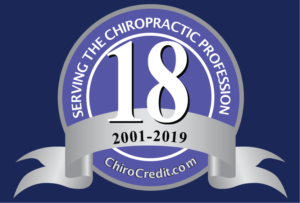In this upcoming interview, John M. Mayer, DC, PhD, CCRP, FACSM will discuss his extensive clinical and research experience in occupational health, wellness, and therapeutic exercise. Dr. Mayer has led teams on numerous clinical trials across the country on various aspects of wellness, clinical management, and prevention funded through federal, state, industry, and foundation sources, including the largest single financial commitment by the US Department of Homeland Security on low back injury prevention in firefighters. Please comment below if you have any questions for us during the interview. I might choose some of them for our conversation.
 Over the last decade, research has demonstrated that spinal manipulation can change various aspects of nervous system function, including muscle reflexes, cognitive processing, reaction time, and the speed at which the brain processes information. One research group from New Zealand (Haavik et al) has hypothesized that the articular dysfunction part of the chiropractic clinical construct, the vertebral subluxation, results in altered afferent input to the central nervous system (CNS) that modifies the way in which the CNS processes and integrates all subsequent sensory input. This processing (i.e., sensorimotor integration) is a central nervous system (CNS) function that appears most vulnerable to altered inputs.
Over the last decade, research has demonstrated that spinal manipulation can change various aspects of nervous system function, including muscle reflexes, cognitive processing, reaction time, and the speed at which the brain processes information. One research group from New Zealand (Haavik et al) has hypothesized that the articular dysfunction part of the chiropractic clinical construct, the vertebral subluxation, results in altered afferent input to the central nervous system (CNS) that modifies the way in which the CNS processes and integrates all subsequent sensory input. This processing (i.e., sensorimotor integration) is a central nervous system (CNS) function that appears most vulnerable to altered inputs.
Investigators utilizing techniques such as transcranial magnetic stimulation and somatosensory evoked electroencephalographic (EEG) potentials have suggested that neuroplastic changes occur in the brain (e.g. primary sensory cortex, primary motor cortex, prefrontal cortex, basal ganglia, and cerebellum). Inducing and recording somatosensory evoked potentials (SEPs) is emerging in scientific literature relating to spinal manipulation (SM). There is evidence to support that SEPs are able to elucidate differences in cortical activity associated with SM. Studies with only a few recording EEG electrodes allow investigation of evoked potential amplitudes and latencies and have shown changes in the N30 somatosensory evoked potential (SEP) amplitudes following spinal manipulation. The N30 response from the frontal lobe peak reflects sensory integration.
With recent advances in the spatial resolution of EEG, it is becoming possible to better anatomically localize the signal. With this study, the authors aimed to utilize brain electrical source analysis to explore which brain sources are responsible for changes in N30 amplitude following a single session of spinal manipulation.
Nineteen young (average age 26 years) subclinical pain volunteers were included in the study. Subclinical pain (SCP) refers to recurrent spinal ache, pain, or stiffness for which the subject had not sought treatment. Subjects were excluded if they had: no evidence of spinal dysfunction, they were in current pain, they had sought previous treatment for their spinal issues, or they had contraindications to receiving spinal manipulation. The EEG signals were recorded with the Neuroscan System from 62 scalp electrodes using the extended 10-20 system montage. Supine subjects received electrical stimulations applied to the median nerve at the right wrist to evoke SEPs. Two trials of 1000 pulses were given in each session: one trial before treatment (control or chiropractic) and one trial after the treatment.
The entire spine and both sacroiliac joints were assessed for segmental dysfunction and adjusted where they were deemed necessary by an experienced chiropractor. Assessment for dysfunction included tenderness to palpation of the relevant joints, restricted intersegmental range of motion, asymmetric muscle tension, and any abnormal or blocked joint play and end-feel of the joints. The control (sham) involved one of the investigators (not a chiropractor) simulating a chiropractic treatment session. This included passive and active movements of the subject’s head, spine, and body, similar to what was done by the chiropractor who provided the actual chiropractic treatment.
Results:
- SEPs were successfully recorded in all subjects
- the majority of subjects were able to correctly guess which intervention group they were in (SM or sham)
- there was a significant post-intervention difference between the two groups – specifically the N30 amplitude was reduced in the spinal manipulation group following the treatment, while it remained stable in the control group
- source localization indicated that the prefrontal cortex tended to have the highest strength during the time interval between 20 and 60 ms
- source strength analysis revealed that chiropractic treatment reduced the strength of the prefrontal source, while all the other strengths remained stable
Key Points:
- Results from this study confirmed that spinal manipulation of dysfunctional spinal segments reduces the N30 SEP peak amplitude and demonstrated that this change is taking place in the prefrontal cortex
- This suggests that, at least in part, the mechanisms by which spinal manipulation improves performance are due to a change in function at the prefrontal cortex
- It is possible that the mechanisms behind pain relief following spinal manipulation in low level pain patients are due to improved sensorimotor integration and appropriate motor control, as this is the key function of the prefrontal cortex
Source: Lelic D, Niazi IK, Holt K, Jochumsen M, Dremstrup K, Yielder P, Murphy B, Drewes AM, Haavik H. Manipulation of Dysfunctional Spinal Joints Affects Sensorimotor Integration in the Prefrontal Cortex: A Brain Source Localization Study. Neural Plast. 2016;2016:3704964.
 Over the last decade, research has demonstrated that spinal manipulation can change various aspects of nervous system function, including muscle reflexes, cognitive processing, reaction time, and the speed at which the brain processes information. One research group from New Zealand (Haavik et al) has hypothesized that the joint dysfunction part of the chiropractic clinical construct, the vertebral subluxation, results in altered afferent input to the central nervous system (CNS) that modifies the way in which the CNS processes and integrates all subsequent sensory input. This processing (i.e., sensorimotor integration) is a central nervous system (CNS) function that appears most vulnerable to altered inputs.
Over the last decade, research has demonstrated that spinal manipulation can change various aspects of nervous system function, including muscle reflexes, cognitive processing, reaction time, and the speed at which the brain processes information. One research group from New Zealand (Haavik et al) has hypothesized that the joint dysfunction part of the chiropractic clinical construct, the vertebral subluxation, results in altered afferent input to the central nervous system (CNS) that modifies the way in which the CNS processes and integrates all subsequent sensory input. This processing (i.e., sensorimotor integration) is a central nervous system (CNS) function that appears most vulnerable to altered inputs.
Many studies show that chiropractic adjustments result in changes to sensorimotor integration within the central nervous system. Do these changes correlate with beneficial clinical outcomes? That is not completely determined yet. It is also not clear whether the changes seen after adjustments are due to the correction of vertebral subluxation, therefore normalizing aberrant afferent input to the CNS, or are they merely due to afferent influx associated with the thrusting into the spine? These questions remain to be answered. The level of CNS involvement and the exact mechanisms underlying these neural adaptations following chiropractic adjustments remain unclear.
This new study reported here sought to investigate possible neural plastic changes with spinal manipulation by measuring H-reflexes and V-waves. The H-reflex is an electrically evoked response that operates via the same neuronal circuitry as stretch reflexes. The H (Hoffmann) reflex may be useful to assess motoneuron excitability in vivo while also reflecting presynaptic inhibition of Ia afferent synapses. The so-called V-wave, which is an electrophysiological variant of the H-reflex, can be recorded during maximal voluntary motor contractions. The elicited V-wave response may be used to reflect the level of efferent neural drive from spinal α-motoneurons during maximal voluntary contraction (MVC).
While several previous studies have shown a decrease in the H-reflex indicating a transient attenuation of motoneuronal activity of the lumbosacral spine in both asymptomatic subjects and low back pain patients, new advances in data collection and processing have occurred since then. The purpose of this study was to take advantage of these recent technical and methodological discoveries related to the H-reflex and V-waves and explore what effect, if any, spinal manipulation of vertebral subluxations will have on them.
Methods:
Two studies were included in the paper. All participants were men, between the ages of 18 and 40 and were required to have evidence of spinal dysfunction and a previous history of subclinical pain, but absence of degenerative conditions of the spine or known contraindications to spinal manipulation. Instrumentation included: 1) surface EMG to record the (SEMG) activity of the soleus muscle (SOL) of the right leg; 2) electrical stimulation producing the H-, M-, and V-waves of the SOL muscle by stimulation of the tibial nerve and; 3) force recordings performed using a strain gauge attached to a custom-made ankle brace, while the subject performed maximum voluntary ankle dorsiflexion contractions.
During study one, ten subjects attended two sessions each, the control and the experimental (spinal manipulation) session. A second study was added wherein a group of eight participants attended two more sessions each, where only force was measured. The order of these sessions were randomized and at least 1 week separated the sessions. All experiments were performed on the right leg, while the volunteers comfortably lay prone on a massage table with their right leg firmly strapped to the table with Velcro. The following measures were collected pre and post interventions: SEMG signals during MVC; H-and M-recruitment curves; H-reflex area under curve normalized to Mmax (Harea/Mmax), H-reflex threshold, V-wave normalized to Mmax (V/Mmax), M-wave slope, H-reflex slope and the mean power frequency (MPF) of a fast Fourier transform (FFT) of the SEMG during MVC.
The entire spine and sacroiliac joints were assessed for segmental dysfunction (vertebral subluxation) and adjusted where deemed necessary by a registered chiropractor with at least 10-years clinical experience using high-velocity, low-amplitude techniques. The control condition involved passive and active movements of the subject’s head, spine, and body into the manipulation setup positions but without performing the adjustment.
Results:
- the threshold to elicit the H-reflex significantly decreased by 8.5% in the spinal manipulation group
- the SEMGs showed a significant drop in the power spectrum after controls but there was no fatigue demonstrated in the power spectrum after spinal manipulation
- for study 1: maximal voluntary contraction as determined by SEMG increased significantly by 59.5% after spinal manipulation and decreased significantly by 13.3% after control
- for study 2: maximal voluntary contraction increased significantly by 16.1% after spinal manipulation and decreased significantly by 11.4% after control
- the V-wave amplitude (V/Mmax ratio) increased significantly by 45% after spinal manipulation and reduced significantly by 23% after control
Key Points
- this study is the first to indicate that chiropractic adjustments can induce significant changes in the net excitability for the low-threshold motor units/and or alters the synaptic efficacy of the Ia synapse
- the improvements in maximal voluntary contraction following spinal manipulation are likely attributed to the increased descending drive and/or modulation in afferents
- spinal manipulation prevents fatigue
- these results suggest that spinal manipulation may be indicated as part of the treatment for the patients who have lost tonus of their muscle and/or are recovering from muscle dysfunction such as stroke or orthopedic operations
- these findings will also be of interest to athletes and perhaps the general public
Reference: Niazi IK, Türker KS, Flavel S, Kinget M, Duehr J, Haavik H. Changes in H-reflex and V-waves following spinal manipulation. Exp Brain Res. 2015 Apr;233(4):1165-73. doi: 10.1007/s00221-014-4193-5. Epub 2015 Jan 13. PubMed
 A recent study incorporated a clinic of midwives and chiropractors to care for suboptimal feeding through a multidisciplinary approach. Suboptimal breastfeeding is a recognized problem among mothers and health care professionals worldwide. The aim was to assess the impact of care and education on breastfeeding and maternal satisfaction after attending the multidisciplinary clinic. On follow-up, 93% of mothers reported an improvement in feeding as well as satisfaction with the care provided. Prior to treatment, 26% of the infants were exclusively breastfed. At the follow-up survey, 86% of mothers reported exclusive breastfeeding. The relative risk ratio for exclusive breastfeeding after attending the multidisciplinary clinic was 3.6 The results from this study demonstrate high maternal satisfaction and improved breastfeeding rates associated with attending the chiropractic and midwifery clinic.
A recent study incorporated a clinic of midwives and chiropractors to care for suboptimal feeding through a multidisciplinary approach. Suboptimal breastfeeding is a recognized problem among mothers and health care professionals worldwide. The aim was to assess the impact of care and education on breastfeeding and maternal satisfaction after attending the multidisciplinary clinic. On follow-up, 93% of mothers reported an improvement in feeding as well as satisfaction with the care provided. Prior to treatment, 26% of the infants were exclusively breastfed. At the follow-up survey, 86% of mothers reported exclusive breastfeeding. The relative risk ratio for exclusive breastfeeding after attending the multidisciplinary clinic was 3.6 The results from this study demonstrate high maternal satisfaction and improved breastfeeding rates associated with attending the chiropractic and midwifery clinic.
http://www.ncbi.nlm.nih.gov/pubmed/26763046
 Over the last decade, research has demonstrated that spinal manipulation can change various aspects of nervous system function, including muscle reflexes, cognitive processing, reaction time, and the speed at which the brain processes information. One research group from New Zealand (Haavik Taylor et al) has hypothesized that the joint dysfunction part of the chiropractic clinical construct, the vertebral subluxation, results in altered afferent input to the central nervous system (CNS) that modifies the way in which the CNS processes and integrates all subsequent sensory input. This processing (i.e., sensorimotor integration) is a central nervous system (CNS) function that appears most vulnerable to altered inputs. Many studies show that chiropractic adjustments result in changes to sensorimotor integration within the central nervous system.
Over the last decade, research has demonstrated that spinal manipulation can change various aspects of nervous system function, including muscle reflexes, cognitive processing, reaction time, and the speed at which the brain processes information. One research group from New Zealand (Haavik Taylor et al) has hypothesized that the joint dysfunction part of the chiropractic clinical construct, the vertebral subluxation, results in altered afferent input to the central nervous system (CNS) that modifies the way in which the CNS processes and integrates all subsequent sensory input. This processing (i.e., sensorimotor integration) is a central nervous system (CNS) function that appears most vulnerable to altered inputs. Many studies show that chiropractic adjustments result in changes to sensorimotor integration within the central nervous system.
A new study sought to investigate possible neural plastic changes with spinal manipulation by measuring H-reflexes and V-waves. The H-reflex is an electrically evoked response that operates via the same neuronal circuitry as stretch reflexes. The H (Hoffmann) reflex may be useful to assess motoneuron excitability in vivo while also reflecting presynaptic inhibition of Ia afferent synapses. The so-called V-wave, which is an electrophysiological variant of the H-reflex, can be recorded during maximal voluntary motor contractions. The elicited V-wave response may be used to reflect the level of efferent neural drive from spinal α-motoneurons during maximal voluntary contraction (MVC).
Results of the study:
- the threshold to elicit the H-reflex significantly decreased by 8.5% in the spinal manipulation group
- the SEMGs showed a significant drop in the power spectrum after controls but there was no fatigue demonstrated in the power spectrum after spinal manipulation
- for study 1: maximal voluntary contraction as determined by SEMG increased significantly by 59.5% after spinal manipulation and decreased significantly by 13.3% after control
- for study 2: maximal voluntary contraction increased significantly by 16.1% after spinal manipulation and decreased significantly by 11.4% after control
- the V-wave amplitude (V/Mmax ratio) increased significantly by 45% after spinal manipulation and reduced significantly by 23% after control
Key Points
- This study is the first to indicate that chiropractic adjustments can induce significant changes in the net excitability for the low-threshold motor units/and or alters the synaptic efficacy of the Ia synapse
- the improvements in maximal voluntary contraction following spinal manipulation are likely attributed to the increased descending drive and/or modulation in afferents
- spinal manipulation prevents fatigue
- these results suggest that spinal manipulation may be indicated as part of the treatment for the patients who have lost tonus of their muscle and/or are recovering from muscle dysfunction such as stroke or orthopedic operations
- These findings will also be of interest to athletes and perhaps the general public
Partner
Donate
Recent Episodes
- 066- Dr. Ronald Farabaugh – The Cost of Chiropractic vs Medical Management of Adults With Spine-Related Musculoskeletal Pain March 19, 2024
- 065- Dr. Clinton Daniels Discusses Manipulation and Prior Spine Surgery, Medications for Back Pain and More June 15, 2023
- 064- Dr. Matt Fernandez Discusses Physical Activity, Exercise and Chiropractic May 11, 2023
- 063- Dr. Robert Trager Discusses Spinal Manipulation, Lumbar Discectomy and Case Reports January 9, 2023
- 062- Dr. Lindsay Gorrell Discusses Spinal Manipulation, the Vertebral Artery, Reporting of Adverse Events January 3, 2023
- 061- Questioning the Relationship Between Chiropractic and ED Visits December 13, 2022
- 060- Dr. Brian Anderson Discusses Chiropractic, Treatment Escalation, Medical Services November 17, 2022
- 059- Dr. Frank Scali – Upper Cervical Spine and Myodural Bridge July 5, 2022
Security – SSL Certificate
Partner
 Chiropractic Science is a Miami University Digital Health Literacy Partner. Health literacy is the ability to read, write, and talk about health habits in a variety of life situations and environments. Our interprofessional partnership promotes the use and dissemination of electronic materials for evidence-based EHealth.
Chiropractic Science is a Miami University Digital Health Literacy Partner. Health literacy is the ability to read, write, and talk about health habits in a variety of life situations and environments. Our interprofessional partnership promotes the use and dissemination of electronic materials for evidence-based EHealth.

